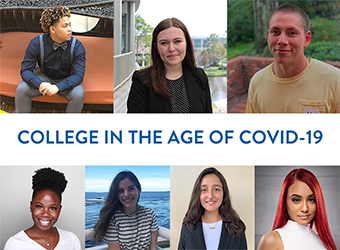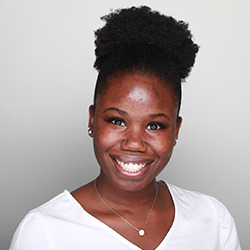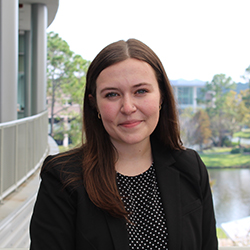 How seven Florida students are coping with the coronavirus
How seven Florida students are coping with the coronavirus
This story is part 3 of FCAN’s College in the age of COVID-19 series, which follows seven college students from around the state as they navigate school, work, and family life this fall. Read Part 1 and Part 2.
As universities wrap up the first full semester shaped by COVID-19, our students express a mix of optimism, exhaustion, and despair. While coronavirus cases continue to grow nationwide, campuses are navigating a semblance of normalcy whilst avoiding being the next hotspot. Many of our respondents share they are planning for a spring semester that will not feel too different from the fall. Looking ahead to the job market, some students have changed majors. Ultimately, the semester is ending as it began: with more questions than answers.
Seeking “some sense of normalcy” through campus resources
Just as instruction has gone remote for many of our students, other important resources like advising also need to be done virtually. Advisors help students set academic goals, find resources, and envision career and life pathways. As a result, students who meet with their advisors are more engaged, get better grades, and are more likely to be retained in school. Advisors also guide students toward participating in high-impact practices, such as undergraduate research experience and learning communities.
Before COVID-19, many institutions increasingly offered online options for advising and other academic support services. Now, students are working through issues, choosing classes, and navigating majors over phone or videoconference. At the University of North Florida (UNF), Carlos shares that he has leaned on his advisor this semester. When it comes to academic support and career pathways, he values his “advisor’s opinion now more than ever.” However, when it comes to choosing his classes, Carlos finds that the mostly-virtual options are hard to pick through. Before, he relied on teacher evaluations and word of mouth to decide which professors to take. Now, he feels that because “all the teachers had to adapt their teaching methods; some teachers perform excellently in person but fail to perform as well virtually. Others are vice versa.” Ultimately, he will have an all-virtual spring and is feeling “slightly unmotivated” by that idea.
Like Carlos, Andrea at the University of Miami has taken advantage of now-virtual resources. She previously used in-person office hours regularly to connect with professors, ask questions, and learn more about the course. Now, she still tries to use virtual office hours, but feels the online format keeps things topical, rather than a space to build connections. “It’s hard and awkward to Zoom a professor when you have no particular questions but just want guidance and aid in general.” In person, she would also “go with no questions, just to hear other people’s questions and learn from that. Not being able to do that is super challenging.” Both Carlos and Andrea also agree that tutoring is particularly difficult in a virtual format. Although the format has strengths — like increased access and less intimidation for students — Andrea finds, “I can’t physically show them my work or where I get tripped up. I can share it through a screen, but then technical issues come into play. This has reflected on my confidence when taking tests and assuring I know what I need to know to succeed.”
Perhaps due to the perceived challenges that come with virtual supports, Tracey at Florida A&M University (FAMU) instead “relied more on my peers and closest friends for support this semester.” As an outgoing person, Tracey found the virtual setting her biggest challenge: “I’m missing out on human interaction.” As a senior graduating this semester, she felt sad to “miss out on all the things I took for granted before my last semester of undergrad.” Another senior, Ally at UNF similarly expressed sadness that her senior year was not what she expected. To counter that, Ally intentionally signed up for one in-person class in the spring, during her last semester at UNF. “Even though it’s less convenient and it comes with some risk, it feels worth it to have some semblance of normalcy.”
At the University of Central Florida (UCF), freshman Briana finds that “more classes are being held in-person, but not that many. It will mostly look like a fully online semester for most students.” Briana, like so many current freshmen, has not had many opportunities to create communities or ties to her school in the mostly-virtual format. An October survey found that about one in three college student respondents did not “feel included” in a circle of friends or a part of the college community. Students continue to experience negative mental health effects from the pandemic: more than half are concerned about their mental well-being as it relates to COVID-19. Briana has “desperately wanted to use the counseling services,” but has found it difficult to get a telemedicine appointment. In a November survey, more than three-quarters of students report they have not used any support from their college to combat their stress or anxiety during this time, instead turning to friends or parents for emotional support.
Mixed feelings about spring as “things will probably look the same”
As students look to the spring semester, they express a variety of feelings. Our graduating seniors entering the workforce feel both stress and optimism. Tracey, who is pursuing broadcast journalism and film, remains “optimistic about the future regardless of the current climate.” She acknowledges that “COVID has altered my previous plans, however, I believe my next move will be my best move.” Victoria, also a graduating senior, has grappled with her next steps. Unsure of her exact plans, she sees graduate school in her near future, while “fresh out of college,” to gain business expertise.
Also optimistic, Andrea is “approaching the spring semester with a new sense of determination.” Her fall semester was lonely and disconnected, and she has felt nervous watching cases increase in the Miami area. Andrea feels particularly grateful that the University of Miami offers a hybrid model, where she can have some in-person class elements, because she can’t “live her life through a screen 100% of the time.” Like our other students, Andrea is looking forward to vaccine distribution in 2021, so she can feel excitement about school, rather than worry.
In contrast, other students express dismay at the thought of a spring semester similar to the fall. For Briana, a freshman who has only experienced college in a virtual format, she is “not only devastated that things will probably look the same next semester, but angry as well.” She feels that there was so much more that could have been done to prevent community spread, yet to see students and others gathering in social groups, she feels “is a slap in the face to the front line workers, but also to the students who want to protect the people in the community.” For Ally, a senior who appreciates remote learning but misses campus social life, the thought of spring semester like the fall is “sobering… in the back of my mind, I kept thinking that things would be back to normal in the spring and that my senior year would close out the way I always expected. It’s sad to think that’s not going to happen.”
It appears many schools will continue to be primarily remote in the spring, which means the good and bad that come with online instruction will remain. A November survey found that college students’ primary concern during the pandemic is about how to stay engaged while learning remotely — more than 70% of students, both in remote and hybrid classes, identify engagement with coursework as a concern. While most students also have concerns about maintaining social relationships, their mental health, their personal finances, and getting a job, that they most identify course engagement as a challenge is worrisome for another primarily-virtual semester.
Students want decision-makers to know they are juggling a lot
When asked what they would tell decision-makers about their experience, our students did not mince words. This semester has been extremely difficult for students who were expecting a certain type of learning style and college experience. Online instruction, the lack of social life, COVID scares, and financial strain are major stressors for college students. Our students are resilient and optimistic, but they are also overwhelmed and stressed out.
Regarding coronavirus precautions, the majority of our students agree: they are grateful for strict policies, and in some cases, think there should be more done to keep students safe. This includes enforced rules, clearer messaging, and keeping students off campus. As universities have grappled with providing a college education and experience in 2020, university policies about testing have shifted, sometimes in response to outbreaks on campus. But our students still fear for their own safety — as well as the safety of their loved ones — and share gratitude for stricter precautions and virtual options.
For Scottie at Valencia College, safeguarding the health of himself and his family is worth the safety measures. “I felt like it was the correct decision to make everything at home because looking back I would have probably been really ignorant and downplayed how dangerous this virus actually was and I could have potentially gotten sick, so I would want them to take their time and to not hesitate in waiting a little longer.”
Other students agree that it is better safe than sorry when it comes to safety. Andrea, who has been contacted by contract tracers telling her she has been exposed to positive cases, feels “the virus can be caught from anyone, anywhere…. even if I do the right thing, it takes everyone taking it just as seriously to truly make a difference.” Therefore, she wants decision makers to know “we can’t tell people how to live their lives, but being very clear about what is responsible and what is not has to be said and implemented by rules, guidelines, and restrictions. It takes everyone coming together to make the difference and beat the virus, especially in a school setting.”
A national survey found most college students trust their professors and friends to do the right thing when it comes to COVID-19 – but nearly half distrust their peers. Some of our students expressed wariness regarding actions of their fellow students on and off-campus, and feel unsafe when other students act with what they feel as “disregard for others.” Because of this, Briana feels that clear and consistent policies are important to guide behavior. “Many of us are scared of the virus and exposing our loved ones to it… I think there should be stronger messaging around campus that doing your part to end coronavirus is a noble act and that it is of the upmost importance.”
Students want decision makers to know that they are still interested in exploring ways to get more students to abide by social distance policies, but they also want people to know how much they are juggling. Beyond the extra time that comes with online instruction, social isolation, and constantly changing policies, students are balancing many things at once, alongside significant worries about the health and safety of their loved ones. In short, our students feel the semester has been harder than most understand. At FAMU, Tracey feels the overall health and wellbeing of students is of utmost concern, and hopes for a renewed focus on students’ health in a holistic sense. In her words, “moving forward, I hope to see school officials and policymakers focus more on the well-being of the students who are the future, and less on the money and finances.”
RELATED ARTICLES:
College in the Age of COVID-19 — Part 1
College in the Age of COVID-19 — Part 2
Key takeaways from “Students Speak: Florida Students Share Their Stories of College in the Age of COVID-19”







